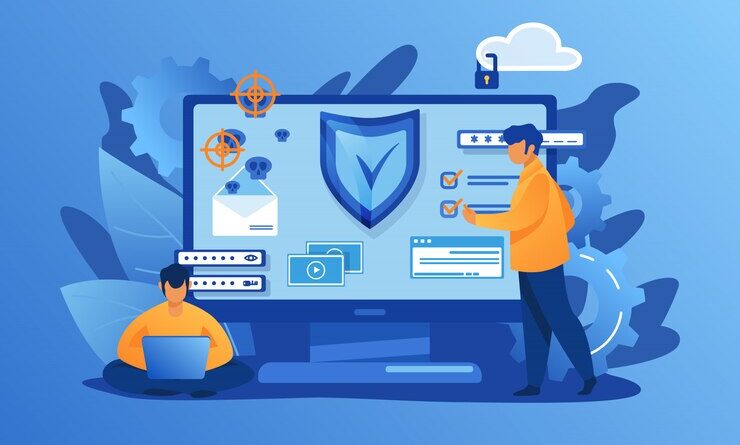Cybersecurity in Web Development
Overview
Cybersecurity in Web Development The meaning of network safety in web improvement can’t be underscored when advanced association fills in as the underpinning of our worldwide society. Delicate data should be safeguarded from digital assaults as an ever-increasing number of individuals, organizations, and states rely upon the web for correspondence, exchange, and diversion. To create a safe web-based climate, this exposition investigates the challenges, best practices, and arising patterns in online protection and its basic job in web improvement.
The Landscape of Growing Threats
Cybersecurity in Web Development Web developers use cybersecurity as a response to the constantly shifting threat landscape. Cybercriminals are continuously looking for new techniques to penetrate organizations and take advantage of weaknesses in sites, applications, and data sets. Normal perils incorporate ransomware assaults, SQL infusions, cross-site prearranging (XSS), information breaks, and disseminated forswearing of administration (DDoS) assaults. These dangers could unfavorably affect one’s standing, funds, and legal standing, in addition to other things.
Recommended Practices for Security in Web Development
1. Safe Coding Techniques
Cybersecurity in Web Development A strong cybersecurity strategy is built on the use of secure coding techniques. Developers need to adhere to industry best practices, which include parameterized queries, input validation, and staying away from hardcoded login credentials. Frequent code reviews may assist in identifying such vulnerabilities and fixing them before they can be exploited.
2. The Encryption of Data
Cybersecurity in Web Development Powerful encryption techniques should be utilized to safeguard delicate information. Secure Attachments Layer (SSL) or its substitution, Transport Layer Security (TLS), ought to be utilized to get information on the way, even though encryption strategies like AES might safeguard information very still.
3. Legal Enrollment and Permission
Cybersecurity in Web Development Strong user authentication techniques, including multi-factor authentication (MFA), aid in making sure that only those with permission may access critical data. Granular authorization controls that are specific to the roles and responsibilities of each user are required.
4. Consistent Penetration Tests and Security Audits
Cybersecurity in Web Development Finding vulnerabilities requires conducting frequent penetration tests and security audits. By simulating actual cyberattacks, these evaluations assist security and development teams in identifying possible vulnerabilities and bolstering defenses appropriately.
5. Patch management and security updates
Cybersecurity in Web Development Updating software, frameworks, and libraries is essential to fixing vulnerabilities that have been made public. To reduce the risk of exploitation, implement a strong patch management procedure that guarantees the timely application of security updates.
New Developments in Cybersecurity Trends
1. Machine learning (ML) and artificial intelligence (AI)
Cybersecurity in Web Development The use of AI and ML technologies to improve cybersecurity is growing. By analyzing enormous volumes of data, seeing irregularities, and anticipating possible dangers, these technologies assist businesses in proactively thwarting cyberattacks.
2. Architecture of Zero Trust
Cybersecurity in Web Development An emerging cybersecurity concept known as “Zero Trust” holds that no entity, internal or external, can be relied upon by default. It reduces the possible effect of a security compromise by requiring constant identification and security posture verification of each person and device entering the network.
3. Security and Development Operations
Cybersecurity in Web Development DevSecOps, or security integration into operations and development, guarantees that security concerns are woven throughout the software development lifecycle. This strategy fosters a culture of shared cybersecurity responsibility by encouraging cooperation between development and security teams.
Final Thoughts
Cybersecurity in Web Development Cyber attackers’ strategies also evolve in tandem with online growth. Web development requires a continuous commitment to cybersecurity to keep ahead of new risks. Developers can make the internet a safer place by embracing new developments, enforcing strong encryption, performing frequent audits, and using secure coding standards. Prioritizing cybersecurity in web development is not simply a recommended practice but also a crucial duty in preserving the availability, confidentiality, and integrity of online information as we traverse an ever-more-linked world.
FAQs about Cybersecurity in Web Development
When it comes to web development, what does cybersecurity mean?
The activity of safeguarding websites, online applications, and web services from security risks, assaults, and illegal access is known as cybersecurity in the context of web development.
Why is web development dependent on cybersecurity?
To protect confidential information, prevent unwanted access, and guarantee the availability and integrity of online applications, cybersecurity is essential to web development. It aids in defending against a range of online dangers, including malware, hacking, and data breaches.
How can I keep up with the most recent security risks and recommended practices?
Keep yourself informed by subscribing to cybersecurity forums, blogs, and reliable security groups. Take part in online development groups, sign up for security newsletters, and routinely check and apply security updates for your web frameworks and libraries.



Leave a Reply